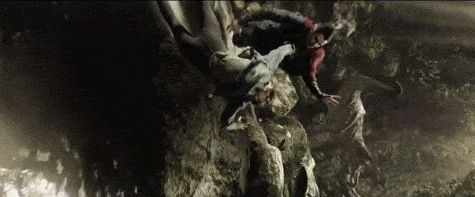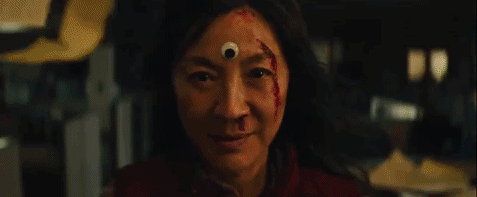
Merry Christmas, Bedford Falls! In the evergreen It’s a Wonderful Life, from 1946, James Stewart is the recipient of a second chance at life. Having seen what could have been, had he not taken the course which leads him to the brink of suicide, one version of Stewart’s George Bailey — and the film’s audience — is allowed a happy ending.
Decades later, the romantic comedy Sliding Doors (1998) applied a deft plot twist to follow the twin paths the central character’s life could take depending on whether she catches a train. (Three years earlier Richard Linklater’s Before Sunrise took the same idea but allowed his strangers on train to pursue just one path of “what-ifs”).
Incidentally, editors and some filmmakers (Christopher Nolan) will tell you that cinema’s greatest superpower is the ability to play with time, and that this is achieve by compressing, expanding and juxtaposing timelines in the edit.
Now cinema is awash with diverging timelines and story forks happening to the same characters at different (or same) ages in multiple universes.

Marvel has gone down the rabbit hole completely, arguably as a cynical exercise in keeping more plates of the MCU spinning. You can read more about this here on NAB Amplify.
READ MORE: Complete Chaos Theory: Building the (Messy) Multiverse of “Everything Everywhere All at Once” (NAB Amplify)
Sony’s animated feature Into the Spider-Verse provided a template for Spider-Man: No Way Home, which featured three Spider-Man characters (Spider-Men?) to become one of the highest-grossing movies of all time ($1.8 billion and change). Christian Holub, writing at Entertainment Weekly, notes that Doctor Strange in the Multiverse of Madness looks to continue the trend by incorporating Patrick Stewart’s Professor X from Fox’s X-Men movies.
The new movie Everything Everywhere All at Once takes wormhole timelines to its logical conclusion but, as reviewers have noted, carries with it a lesson or two about how we might approach the noise of the now and the impending chaos of the metaverse.
“What makes Everything Everywhere All at Once so powerful is the multiverse, a dazzling antidote to the fact that real life these days feels like it’s been designed to blur and pummel our emotions into dullness,” says Vox writer Alex Abad-Santo.
The multiverse, as depicted in the movies, is a world full of endless potential; multiple parallel universes spinning in synchronicity; and the possibility of alternate, powerful, seemingly better versions of ourselves.
“At a time when a pandemic, wars, and political cruelty have become constant, inevitable presences in our daily lives, it’s the ultimate fantasy for this moment,” Abad-Santo adds.
It turns out that the multiverse actually makes a great metaphor for the internet, too, where people can inhabit the same physical space but have wildly different perceptions of reality based on which online spheres they flock to.
“Living on the internet every day as so many of us do, it’s easy to feel like you’re living through a never-ending crisis,” says Holub. “Every feed you check makes it seem like another world is ending: distressing updates about the climate or a new war breaking out or a public shooting ripping through families and communities. We have access to more information at any time than ever before in human history, yet this abundance leaves us feeling more alienated and depressed than uplifted and inspired.”
He argues that all of this knowledge can be helpful; if only we can use it in the right way. Here’s where the fictional concept of the multiverse encourages thoughtfulness by showing us what could’ve been, he says.
“The beautiful thing about Everything Everywhere All at Once is that it reminds us that we’re all capable of traversing (and saving) reality. Humility, empathy, a willingness to admit mistakes — these are the things that stop [the villain in the film] from destroying the multiverse, not a cosmic fistfight (as you might find in run of the mill superhero fantasies).”

READ MORE: The ‘weird journey’ to make Everything Everywhere All at Once (Entertainment Weekly)
But what if it weren’t all a fantasy? What if we’ve been living in the multiverse all along?
In the realm of quantum physics a lot of things are theoretically possible, so let’s indulge this train of thought as Abad-Santo does in conversation with Spyridon Michalakis, a mathematical physicist at the California Institute of Technology.
Michalakis is no random boffin — “I’m the science consultant for Ant-Man and I introduced the quantum realm [to Marvel],” he explains. “When I consulted with [star] Paul Rudd and [director] Peyton Reed, they wanted to know what happens when you shrink.”
He continues, “If you really shrink you get to the source code of reality itself. Space and time just don’t operate the same way at that level. I tried to infuse the movies with as much actual science as possible. At some point, the writers were more excited about the real science than the hocus pocus-like stuff.”
Having established his credentials, Michalakis then explains that basically the multiverse is grounded in Einstein’s quantum mechanics.
“Space and time are one single, singular construct,” he explains in a 101 of Einstein’s theory of relativity. “There’s not like you have space and then time; it’s space x time. Moreover, quantum space time is a superposition: a quantum superposition of an infinite number of space times, all happening at the same time.
“This illusion — basic physical reality — is the fact that human beings have very specific points of view, ways of observing the superposition.”
It means also that we’re kind of stuck in observing just one reality, not the multiplicity of them — but we could if only we had a brain the size of a planet.
He makes this startling observation by mixing science with a cinematic metaphor.
“The frame rate of the human mind is so low relative to the frame rate of the universe,” he says. “Let’s say we only perceive 100 frames-per-second. We can be aware of our lives and choices we make, but then the frame rate of the universe (where you could be flicking between different timelines) is 40 orders of magnitude above that.
“We’re all trying to figure out the plot of the universe by just watching the beginning and the end of the movie, the first and last frame. We’re just reconstructing the in-between the best we can. That’s where the multiverse hides; it hides there in between frames. Honestly, I think that the frame rate of the universe truly is infinite, not even finite, very, very large. And we’re so far away from that.”
“The whole point, and what we’ve seen, is that our intuition just breaks so badly, so badly at every scale. We’re just missing most of it. But we try to make the best theories about it as we can.”
“I want people to know — especially young people trying to figure out where they fit in this world — that they have power to make anything happen, and make that world where they can do amazing things. They can really take control and become that version of themselves that unlocks their true potential.”
— Spyridon Michalakis
Read It on Amplify: You’re Living in Your Own Private Multiverse
Read It on Amplify: Because Science! Here’s How a Multiverse Is Totally Possible
It’s enough to make you despair. As Abad-Santo points out the key word is fate. “A lot of storytelling wrestles with the idea of destiny and our choices, and whether we have control of our future,” he says. “The multiverse seems like it offers a freedom from that, in that your fate could be anything that you choose, or whatever your quantum superposition is.
But we don’t have the mental capacity — the frame rate — to see round the corner let alone into a parallel universe.
That doesn’t mean we should give up, as everything is out of our control and we can’t go back to a junction like George Bailey and reset the outcome.
“At some point, there’s a really tempting choice to just be cynical and say there’s nothing I can do and that no version of me makes a difference here,” says the physicist.
“I want people to know — especially young people trying to figure out where they fit in this world — that they have power to make anything happen, and make that world where they can do amazing things. They can really take control and become that version of themselves that unlocks their true potential.
“I feel like the buzz phrase over the past two years has been “existential crisis.” There’s been a general feeling of like, what does it even matter if I exist?
“The multiverse fantasy, to me, feels like the inverse of that. There’s something beautiful in the idea of existing everywhere all at one time. The idea that this life, your life, everything everywhere matters so much right now.”
READ MORE: Everything Everywhere All at Once, explained by a quantum physicist (Vox)
WATCH THIS: A Brief History of the Multiverse
Welsh astrophysicist Geraint F. Lewis, co-writer of Where Did the Universe Come From? And Other Cosmic Questions, explains the multiverse theory, including its origins and milestone developments, as well as what might come next.
“There are new universes born beyond our cosmic horizon,” he says. “Multiverse theories have proliferated, hoping to answer the deepest questions about what we, and the entire cosmos is.”
The hour-long video is separated into five parts: How Big is the Universe?, The Bubble Multiverse, The Cyclical Multiverse, Branes in the Bulk, and Many Worlds.
By thoroughly examining the history of the multiverse and what we know about it today, Lewis makes a complex topic easier to understand:

